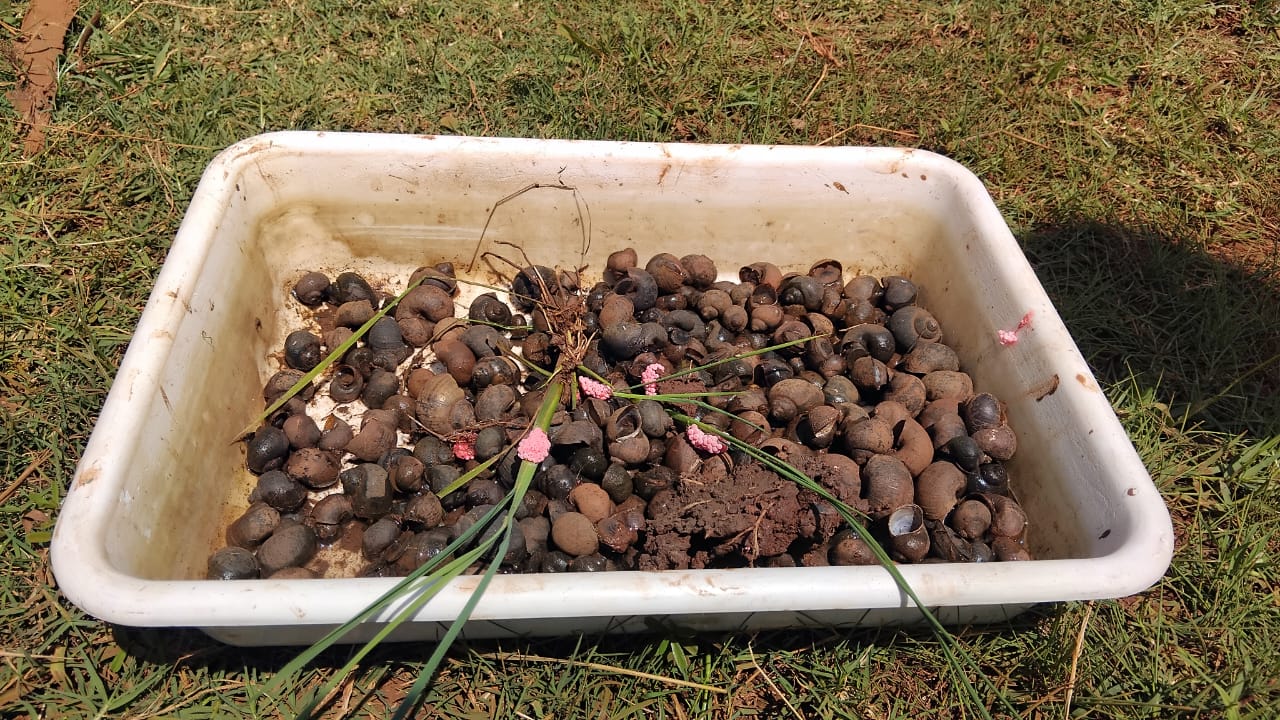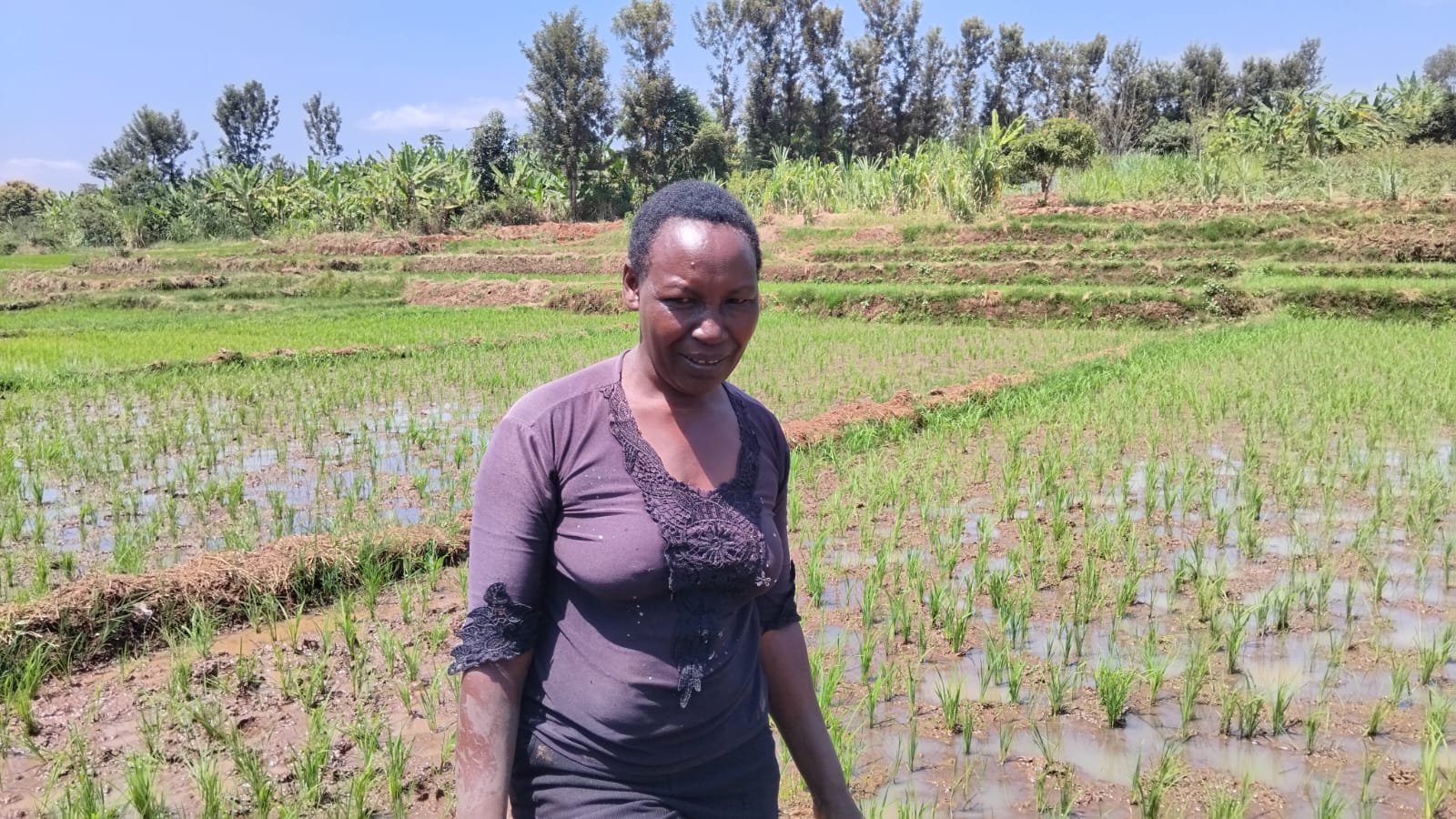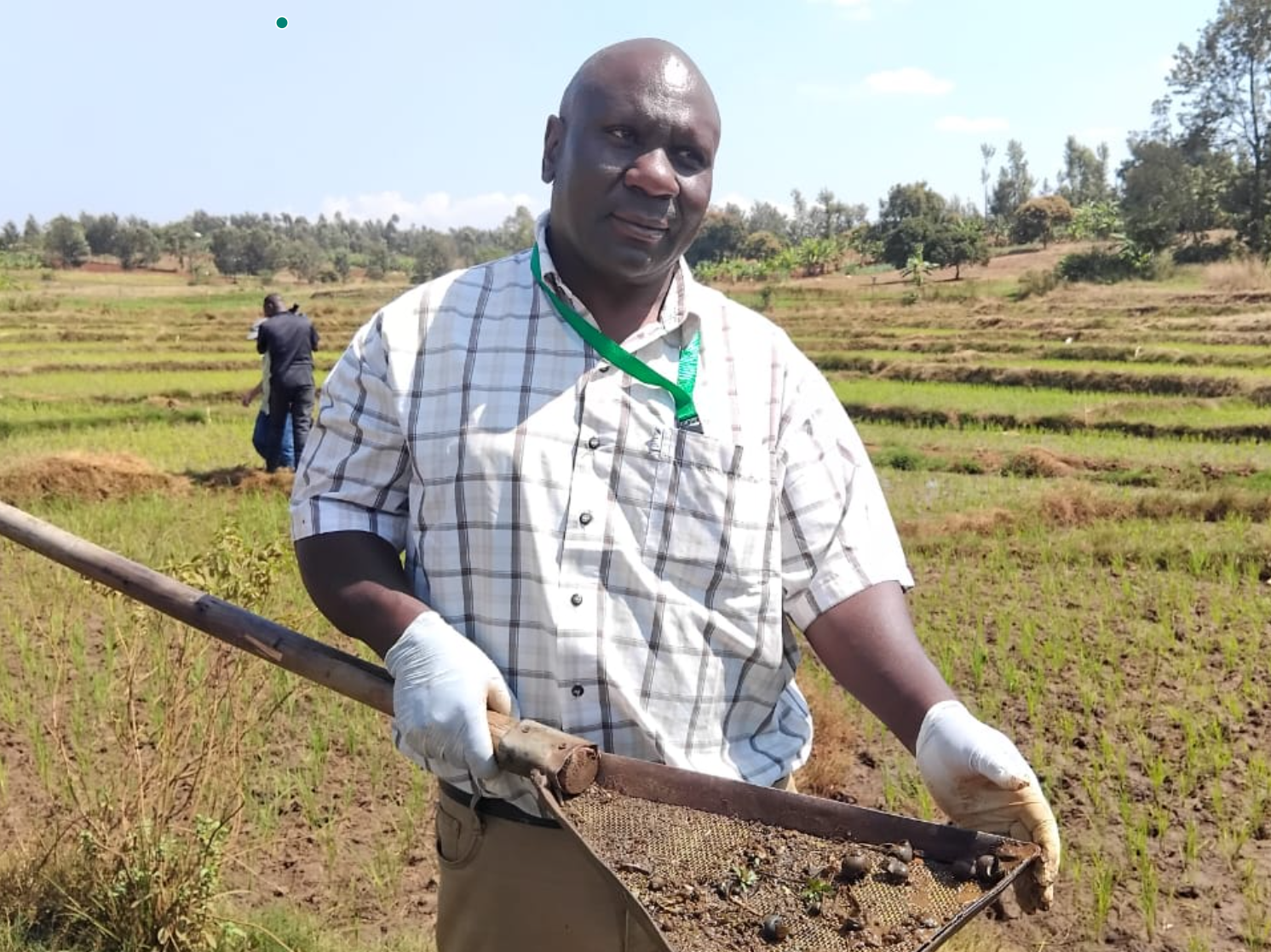 Apple snails collected in a rice paddy in Mwea.
Apple snails collected in a rice paddy in Mwea.
Roselyne Njeri’s daily fight for her livelihood, against the snails that have infested rice farms in Mwea, never ends.
The snails are not easy to spot. They come in dark, coiled shells, and when you place many of them together, they resemble fragments of dark clay pots.
Apple snails feed aggressively on tender rice seedlings, and one cluster can clear entire patches of newly transplanted rice in one night. This forces farmers to reduce the risk by physically fishing out snails from the paddies, one by one.
“This pond is very muddy. So you can't use mud boots; it’s only bare feet. You have to fish out the snails with your hands,” Njeri says, crouching down and scooping at the murky water. “It is very difficult and they’re multiplying very fast.”
The apple snail is no bigger than a small avocado seed when fully mature, but the young ones are tiny, and you can hold 20 of them in your palm.
 Roselyne Njeri, a farmer at Gatitika village in Mwea East Constituency. Photo/ John Muchangi.
Roselyne Njeri, a farmer at Gatitika village in Mwea East Constituency. Photo/ John Muchangi.
She spends long hours bending over, digging them out of her fields before they devastate the crop. “What bothers me is that because of bending for an extended time, fishing out snails, you have a sore arm, a sore leg. I even have scars all over my palms and fingers because their shells cut me.”
However, the pests continue to prevail despite her best efforts. “We use chemicals to kill the snails, but the chemicals don't do much. They don’t die,” Njeri says. “Usually, I sell six bags from my paddy. If it continues like this, I will sell four bags.”
Most of the more than 5,000 farmers who produce the bulk of Kenya’s locally grown rice in Mwea are affected.
Another farmer, Bernard Maina, explains that the infestation began around 2020 and that the explosion has been relentless.
The snails thrive in the standing water of rice paddies, laying clumps of bright pink eggs that hatch into hundreds of tiny, plant-munching juveniles.
“At the beginning, the number was small. As we go on day by day, the number increases. They can destroy almost everything; they can even eat the whole shamb,a and you're left with nothing.” Bernard explains.
But a group of scientists from Israel and Kenya believe the solution may already exist, right in the water.
“The solution that we are suggesting involves introducing prawns *(pictured) into the rice paddies. It's a win-win situation,” says Prof Amir Sagi, a leading crustacean biologist from Ben-Gurion University in Israel. “The prawns eat the young small snails, and the farmers can harvest the prawns and sell them.”
 Bernard Maina, 68 years old, owns a half-acre rice farm at Marura village, Kathiga location, in Mwea West Sub-County. Photo/ John Muchangi.
Bernard Maina, 68 years old, owns a half-acre rice farm at Marura village, Kathiga location, in Mwea West Sub-County. Photo/ John Muchangi.
Sagi and his colleagues have worked with freshwater prawns in Asia for years, and he insists the results speak for themselves. “It is very effective in reducing the amount of snails in the ponds and the prevalence of Bilharzia disease. It has been implemented in many countries in the world, like Thailand in China. We have very good technology to ensure 100 per cent that all prawns are female.”
In Senegal, researchers reintroduced native river prawns that naturally prey on snails. Within months, infected snail numbers at one river access point dropped by 80 per cent, and human schistosomiasis infections fell by nearly 18 per cent. Laboratory trials with the giant freshwater prawn, Macrobrachium rosenbergii, also show that a single prawn can wipe out an entire snail population in a tank within weeks, eating hatchlings before they grow to reproduce.
That detail is crucial in Mwea, where pink snail eggs appear by the thousands. The population explosion can be stopped if prawns eat them at that vulnerable stage.
“The idea is to establish a prawn production so the farmer will have both prawns and rice. The prawns will grow and then be introduced into the paddies. They will eat the snails, and at the end of the season, farmers can sell the rice and the prawns. They have two products,” Prof Sagi says. “This prawn species is the only one that is monosex. We developed the technology for growing them in monosex; if they are monosex, they cannot reproduce. We don't want to add one more invasive species.”
 Prof
Amir Sagi, a leading crustacean biologist from Ben-Gurion University in Israel.
Prof
Amir Sagi, a leading crustacean biologist from Ben-Gurion University in Israel.
Dr Amit Savaya, a mariculture project manager from Israel’s Ministry of Agriculture, says the apple snail problem is not confined to Mwea. “We know that this problem of the apple snails has arrived here in Kenya in the past five years, in Uganda and probably Tanzania as well,” he says. “We hope that by learning how to implement the prawn solution here in Mwea, we could later enlarge the scale and use them both as food protein and also for controlling apple snails.”
No one knows how the snails arrived in Mwea, but it is thought they came through the ornamental aquarium trade. “In most places in the world, they arrive from the ornamental aquarium market. People grow those snails as an ornamental species, and probably someone threw them into the environment.”
Dr Savaya stresses the prawns are safe. “Ben-Gurion's lab has developed a technology which does not include any GMOs to create monosex prawns. It is totally safe for human consumption and the environment. If you use only one sex, they cannot reproduce. In this species of prawn, the females are less aggressive than the males, so you can stock them in higher densities and they are very effective biocontrol agents.”
He points out that for the plan to succeed, the prawns cannot be imported forever. “If we import prawns from Israel, it would be very expensive. The idea is to grow them locally here in Kenya. We can bring the knowledge, but the prawns must be grown here, and that is the only way it will be sustainable.”
 Geoffrey Maina is a principal lab analyst at Kemri. His
major areas of interest are the control of schistosomiasis using crustaceans.
Geoffrey Maina is a principal lab analyst at Kemri. His
major areas of interest are the control of schistosomiasis using crustaceans.
The Israelis will collaborate with the Kenya Medical Research Institute (Kemri) and other government institutions in Mwea to grow and test the concept in tanks before scaling up. Savaya said this work would begin later this year, before field trials next year.
Kemri laboratory analyst Geoffrey Maina says the scale of the infestation is shocking. “During peak season in Mwea (when the rains begin), in one one-meter square of field you can find about 200 snails,” Maina notes. Their impact is real: “We did research with CABI; these snails are causing up to 16 per cent losses in rice yield.”
Past studies have highlighted that the pest can reduce yields by as much as 50 per cent.
That loss translates into millions of shillings in reduced harvests, extra labour costs, and higher prices for consumers.
Worse, the battle against the snails has driven farmers toward agrochemicals that may be more dangerous to humans than the pests themselves.
“Farmers spend a lot of time picking them out or spraying pesticides. Some of these agrochemicals are very toxic to humans. We worry there might be rising cancer cases in these regions,” Maina says.
The apple snails do not spread bilharzia, but can transmit other parasites, such as rat lungworm.
However, the prawns would still feed on other freshwater snails that carry the parasite responsible for bilharzia.
“If we break the transmission cycle at the snail, that would also be a big step towards eliminating the disease,” says Maina, who has worked in Mwea for 20 years.
Njeri and Bernard say that although the idea of prawns patrolling their fields sounds unusual, they are desperate for relief. Their scars, empty bags, and weary voices carry the weight of a farming community under siege.
“We have sprayed it, and it still doesn’t die,” Njeri says.












